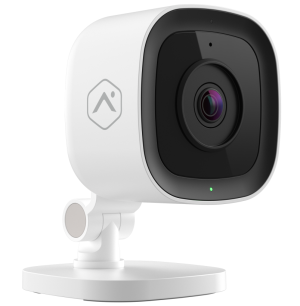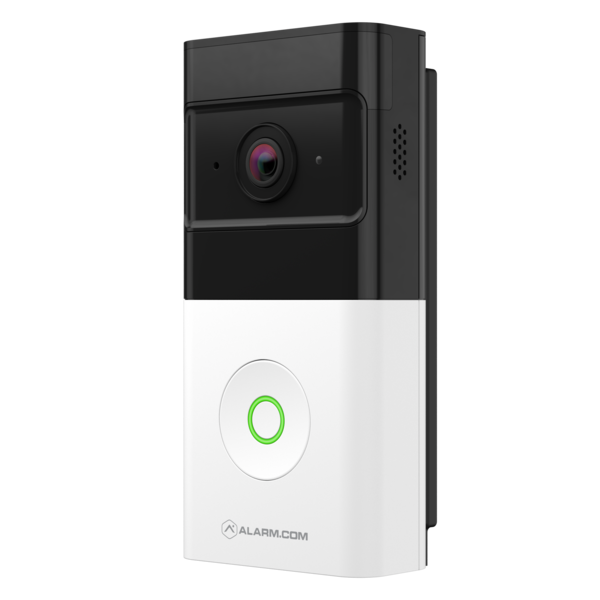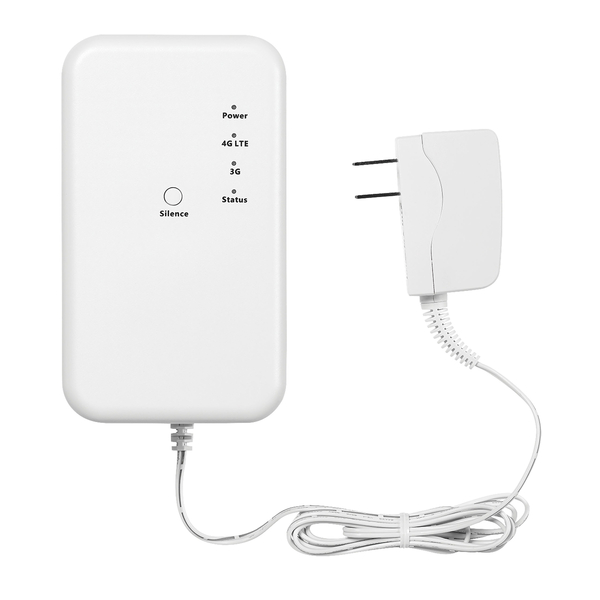The impressive DSC PowerG+ lineup is coming soon, offering a suite of powerful new features. You can soon access convenient over-the-air firmware updates, live battery level reporting, and easy system pairing. Completing this update, the entire lineup will feature a unified, modern look.
One thing that won't change with PowerG+ is the staggering transmission range you can expect from each sensor. Both PowerG and PowerG+ offer a reliable transmitting range of up to 1.24 miles or 1.99 km! It is unlikely you'll need a repeater with these sensors, but if you do, a PowerG+ repeater is available.
In many cases, you may not need a repeater, but the installation of a repeater could save money on sensor batteries. That's because like PowerG, the PowerG+ sensors use adaptive transmission. That means the sensor communicates with the receiver to determine what the minimum necessary transmitting power is to reach it. By determining and then using this minimum required transmission strength, the sensor conserves battery power.
PowerG+ Sensors
Here we'll list all the PowerG+ Sensors we know about currently, and provide a brief description of each. Something all PowerG+ sensors have in common is backward compatibility, or what they call "fallback mode". What this means is that any panel that supports PowerG will work with these sensors.
However, in the Qolsys IQ Panel 4 lineup, for example, the panel will need to be on software version 4.6.0 to fully support all of the PowerG+ added features, such as battery level reporting and over-the-air firmware updates.
DSC PGP9303 - Vanishing Door/Window Sensor

Say goodbye to frustrating installation with the new DSC PGP9303 Vanishing Door/Window Sensor. This slim contact comes with a brilliantly designed, full-length magnet that matches the sensor's height. No longer do you need to pinpoint the sweet spot for magnet placement; just ensure the magnet is anywhere along the correct side of the sensor for consistent and reliable operation.
The PGP9303 comes in white, but replacement plastic shells are available in black, grey, and brown. The colored plastics will likely be sold in quantities of five (5) or ten (10) per SKU. The details on that are not yet available. Either way, once you receive the colored plastic, just pop the printed circuit board and the magnet out of their white plastic shells and pop them into the replacements. Then mount using either screws or two-sided foam tape.
Quick Specs:
-
Battery Type: 3 V Lithium CR2450 Panasonic, Duracell, or GP battery only.
-
Dimensions: 2.7" x 1.2" x 0.5" (68 mm x 31 mm x 12 mm)
-
Operating Temperature: 14°F - 131°F (-10°C - +55°C) UL verified temp range: 32°F - 120°F (0°C - +49°C) only
-
Frequency Band: 912 MHz - 919 MHz
PGP9303 Magnet Gap Spacing Details:

| Non-Metallic Surface
|
Supports
|
Metallic Surface
|
|
Opening
|
Closing
|
Direction
|
Opening
|
Closing
|
| 1.06" (27mm)
|
.91" (23mm)
|
X
|
.47" (12mm)
|
.39" (10mm)
|
| .63" (16mm)
|
.55" (14mm)
|
Y
|
.59" (15mm)
|
.47" (12mm)
|
| 1.06" (27mm)
|
.87" (22mm)
|
Z
|
1.02" (26mm)
|
.87" (22mm)
|
DSC PGP9945E Door/Window Contact with Aux Input

The DSC PGP9945E sensor is a versatile door/window contact featuring an auxiliary wired zone input. This smart design allows you to secure two separate openings with a single transmitter, maximizing efficiency. While not as ultra-slim as the PGP9303, this device maintains a small form factor and boasts the same impressive transmitting range.
Like the PGP9303, the PGP9945E comes in white, but color plastic replacements can be ordered in black, gray, or brown. Both the sensor and the magnet plastic can be replaced with the color option of your choice. The full-size magnet also simplifies magnet placement during installation.
The auxiliary wired input can be configured for normally open, normally closed, single end-of-line, double end-of-line, or triple end-of-line resistor supervision.The resistor value used is 5.6 KΩ.
In addition to securing multiple points, the PGP9945E is equipped with ambient temperature sensing capabilities. Although Qolsys and Alarm.com have not yet detailed their plans for this data, it could potentially be used to inform and optimize your building's climate control system, allowing for more precise automation based on real-time temperature readings from various points.
Quick Specs:
-
Battery Type: 3 V Lithium CR123A GP battery only.
-
Battery life: 8 years with typical use at room temperature.
-
Dimensions: 3.5" x 1.5" x 1.2" (89 mm x 37 mm x 30 mm)
-
Operating Temperature: 14°F - 131°F (-10°C - +55°C) UL verified range: 32°F - 120°F (0°C - +49°C) only
-
Frequency Band: 912 MHz - 919 MHz
-
Auxiliary Input Wire Length Limit: 32.8' (10 m) using 22 AWG.
PGP9945E Magnet Gap Spacing Details:

| Non-Metallic Surface
|
Supports
|
Metallic Surface
|
|
Opening
|
Closing
|
Direction
|
Opening
|
Closing
|
| .94" (24mm)
|
.79" (20mm)
|
X
|
.35" (9mm)
|
.27" (7mm)
|
| .59" (15mm)
|
.47" (12mm)
|
Y
|
.47" (12mm)
|
.35" (9mm)
|
| 1.18" (30mm)
|
.67" (17mm)
|
Z
|
.71" (18mm)
|
.55" (1mm)
|
DSC PGP9914 Indoor Motion PIR Detector

The DSC PGP9914 PowerG+ Indoor Motion PIR sensor offers robust security detection with several advanced features. It boasts an expanded range, capable of detecting motion up to 39.3' (12m) away. The sensor incorporates True Motion Recognition™, an advanced algorithm that helps differentiate between actual intruder movement and other potential disturbances, like curtains being moved by air currents, significantly reducing false alarms.
For households with pets, the PGP9914 includes optional built-in pet immunity, which can prevent false alarms caused by animals weighing up to 85 pounds (38 kg). Sensor management is simplified through battery level reporting and over-the-air updates to add features and provide issue resolution. Additionally, installation is made easy with features like battery pull tabs and QR codes instead of an enrollment button. Some PowerG sensors offered this simplified enrollment, but all PowerG+ sensors have it.
Quick Specs:
-
Battery Type: 3 V Lithium CR123A Panasonic, Duracell, and GP only.
-
Battery life: 6 to 8 years with typical use at room temperature.
-
Dimensions: 3.4" x 2.5" x 1.6" (86 mm x 63 mm x 40 mm)
-
Operating Temperature: 14°F - 131°F (-10°C - +55°C) UL verified range: 32°F - 120°F (0°C - +49°C) only
-
Frequency Band: 912 MHz - 919 MHz
-
Maximum Coverage Area: 39' (12 m) 90°.
-
Pet Immunity Limit: Up to 85 Lbs (38 kg).
DSC PGP9934P Indoor PIR Cam

The DSC PGP9934P PowerG+ Indoor PIR Cam is the next generation in motion detection. This device combines advanced PIR capabilities with powerful visual verification, delivering improved, high-resolution color images and video clips viewable in real time via the Alarm.com app. It offers fast alarm verification, allowing users to receive real-time visual alarm confirmation upon motion detection.
The extended camera range covers up to 40' (12m) in daylight and 33' (10m) in darkness, ensuring optimal room coverage. For motion detection, it provides 40' x 40' (12m x 12m) coverage at a 90° angle, with optional built-in pet immunity to reduce false alarms caused by pets.
Quick Specs:
-
Battery Type: (2) 3 V Lithium CR123A
-
Battery life: 5 years with typical use at room temperature.
-
Recommended Mounting Height:
- 6' - 8' (1.8m - 2.4m) - Non pet-tolerant
- 6' - 7' (1.8m - 2.1m) - Pet-tolerant
-
Dimensions: 4.9" x 2.5" x 24" (125 mm x 63 mm x 60 mm)
-
Operating Temperature: 14°F - 122°F (-10°C - +50°C)
-
Frequency Band: 912 MHz - 919 MHz
-
Maximum Coverage Area: 40' x 40' (12m x 12m)/90°.
-
Camera Type: CMOS
-
Camera Range: 40' (12m) in Daytime, 33' (10m) in Complete Darkness
-
Color & Resolution (Color and B&W):
- QVGA: (320 x 240 pixels)
- QQVGA: (160 x 120 pixels)
- HD: (1280 × 720 pixels, Peek-In only)
- VGA: (640 x 480 pixels)
-
Frame Rate: Up to 2 frames per second
-
Camera Angle: 90° Wide Angle
-
Camera Response: Instant capture functionality
DSC PGP9922 Glass Break Detector

Safeguarding your windows and glass doors is essential, and the DSC PGP9922 PowerG+ Glass Break Detector delivers advanced, reliable detection for your home or business. This detector offers an impressive glass break detection range of up to 25' (7.6m), or 20 feet (6m) depending on the size of the protected glass. Beyond its robust performance, it features a modern design that seamlessly integrates into any aesthetic without compromising security.
Installation is remarkably easy, thanks to convenient battery pull tabs and QR codes for quick device enrollment. For ongoing management, the detector supports over-the-air updates for remote sensor upgrades and provides battery life reporting allowing you and your alarm dealer to monitor sensor battery levels. Best of all, the PG9922 comes fully calibrated, eliminating the need for manual adjustments during installation.
Arguably the best feature of this new glass break detector is its appearance. In the past, consumers have often prioritized motion detectors over glass break detectors, in spite of the fact that a glass break sensor can prevent a break in while a motion detector is usually engaged only after an intrusion has occurred. I believe one reason for that is that glass break sensors have historically been...well, ugly. The DSC PGP9922 aims to change that.
Quick Specs:
-
Battery Type: (2) 3 V Lithium CR123A, GP or Panasonic only
-
Battery life: 5 years with typical use at room temperature (77°F (25°C) Note: Not evaluated by UL/ULC).
-
Minimum Distance from Glass: 5' (1.5m)
-
Dimensions: 4.2" x 2.7" x 1.2" (107.5mm x 69mm x 30mm)
-
Operating Temperature: 14°F - 120°F (-10°C - +48.8°C) UL verified range: 32°F - 120°F (0°C - +49°C) only
-
Frequency Band: 912 MHz - 919 MHz
-
Max Detection Range:
- 25' (7.6m) For Glass that is a Minimum of 15 3/4" x 15 3/4" (40cm x 40cm)
- 20' (6m) For Glass between 12" x 12" (30cm x 30cm) to 15 3/4" x 15 3/4" (40cm x 40cm)
- For UL/ULC the maximum verified range is 20' (6m).
-
Glass Type: UL Tested on Plate, tempered, wired, laminated, covered, and sealed insulated.
-
Glass Thickness (per UL tests):
- Plate: 1/8" - 1/4" (3.2mm - 6.4mm)
- Tempered: 1/8" - 1/4" (3.2mm - 6.4mm)
- Wired: 1/4" (6.4mm)
- Coated: 1/8" - 1/4" (3.2mm - 6.4mm)
- Laminated: 1/4" (6.4mm)
- Sealed Insulating: 1/8" - 1/4" (3.2mm - 6.4mm)
- NOTE: Laminated and Sealed Insulating glass are protected only if both the inner and outer panes are broken.
-
Room Size:
- At least 10' x 10' (3m x 3m)
- At most 40' x 40' (12m x 12m)
DSC PGP9986 PowerG+ Water Tile - Flood and Freeze Sensor

The DSC PGP9986 is a PowerG+ flood and freeze detector commonly referred to as the Water Tile. It can detect water leaks from sinks, dishwashers, washing machines, and any other area where water is used, but the floor should remain dry. It also has the option to alert you when the temperature drops, allowing you to prevent burst pipes.
The Water Tile can be used alone or with an external probe or sensing cable. You can check out the installation instructions. The external probe must be used alone while up to two (2) sensing cables can be used by connecting the second cable into the end of the first. The probe and sensing cable come with a wall mounting bracket that they connect to. The Water Tile then slides into the bracket and clicks into place. Since the sensor itself should not be submerged, it is best to use a probe or cable when monitoring areas where the water might get too deep for the Water Tile itself.
Quick Specs:
-
Power Supply: Battery.
-
Battery Type: 2 x 3V Lithium CR2450 Panasonic, Duracell, or GP batteries only.
-
Expected Battery Life: 5 years with typical use at room temperature 77°F (25°C).
-
Ingress Protection (IP) Rating: IP65.
-
Freeze Alert Temperature (Ambient): 41˚F (5˚C)
-
Operating Temperature: 14°F - 131°F (-10°C - +55°C)
-
Dimensions (L x W x H): 2.6" x 2.6" x 0.43"
(65 mm x 65 mm x 11 mm)
DSC PGP9920 PowerG+ Wireless Repeater

The DSC PGP9920 PowerG+ Wireless Repeater is installed in the field, usually at the edge of the PowerG receiver's range. It listens for PowerG and PowerG+ sensor transmissions. If it hears a transmission, it repeats it to ensure that it reaches the receiver. The PGP9920 has it's own power source, but like the alarm panel it works with, it also has a backup battery to provide 48 hours of standby power in the event of a power failure. This keeps your entire system up and running in the event of an extended power outage.
For supervision purposes, the PGP9920 is programmed into the panel as a zone. This allows the panel to supervise the repeater for power outages, low battery conditions, and tamper. The PGP9920 has both a cover and a back tamper. So, whether it's pulled off the wall, or the cover is removed, the alarm panel can signal a tamper condition.
As we mentioned before, PowerG and PowerG+ devices use adaptive transmission when communicating with the alarm system. This allows the sensor or repeater to use only as much power as is necessary to send a signal. This helps to conserve battery power, and is why these devices have such long battery life. For this reason, even when a repeater isn't necessary, it may be worthwhile to add one in particularly large installations to help conserve power.
Quick Specs:
-
Power Supply: 100-240 VAC to 6V/1A DC
For UL Listed product, 120 VAC, 60 Hz. Sure-Power type SW-060100A.
-
Battery Type: Rechargeable. 3.6 V 2200 mAh Li-ion Q-LITE type ICR18650.
-
Backup Battery Duration: At least 48 Hours, for UL Listed product 24 Hours.
-
Dimensions: 7.1" x 7.1" x 1.9" (180mm x 180mm x 48mm)
-
Operating Temperature: 32°F - 120°F (0°C - +49°C) UL verified range: 32°F - 120°F (0°C - +49°C) only
-
Frequency Band: 912 MHz - 919 MHz
Most of these PowerG+ products are not yet available, with the exception of the DSC PGP9934P Indoor PIR Cam. Those are available right now! So, if you click on any of the other product links above, you'll see some crazy pricing. This is so that we can prepare for the products to go live, while discouraging anyone from attempting to order a product that's not yet available.
Once these products become available, we'll have another blog with that announcement and the actual pricing will go up on the page. We're just excited about this launch and want to make the full product descriptions available now, rather than waiting. Product availability will very likely coincide closely with the release of the 4.6.0 software update for the Qolsys IQ Panel 4 systems, so be on the lookout for that as well.

 To see this new feature, you must have an Alarm.com account and iOS app version 5.9.7+ or Android app 5.7.6+. This feature has been slowly rolling out over the past couple of weeks, so if you're on the latest version and don't see it yet, don't worry, it's coming. The alarm recap becomes available on the app Home screen ten (10) minutes after the alarm's conclusion (i.e. post disarm).
To see this new feature, you must have an Alarm.com account and iOS app version 5.9.7+ or Android app 5.7.6+. This feature has been slowly rolling out over the past couple of weeks, so if you're on the latest version and don't see it yet, don't worry, it's coming. The alarm recap becomes available on the app Home screen ten (10) minutes after the alarm's conclusion (i.e. post disarm).





























































